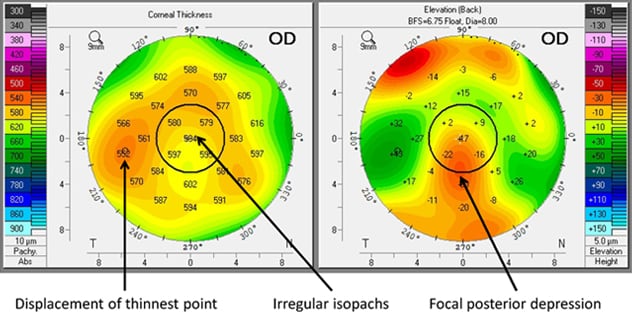April 20, 2021
There are no simple indicators of disease prognosis for Fuchs' endothelial corneal dystrophy (FECD). Although diagnosis of FECD is made by detecting the presence of guttae by slit-lamp examination, detecting the presence of subclinical corneal edema that frequently accompanies FECD is more challenging.
Studies conducted by Sanjay V. Patel, M.D., and fellow researchers with Ophthalmology at Mayo Clinic in Rochester, Minnesota, sought to determine whether Scheimpflug tomography pachymetry map and posterior elevation map patterns can predict the prognosis of FECD independent of central corneal thickness (CCT), and whether subjective interpretation of these maps was repeatable. The studies were published in Ophthalmology and American Journal of Ophthalmology in 2020.
FECD prognosis prediction
Subclinical edema in Scheimpflug imaging maps

Subclinical edema in Scheimpflug imaging maps
The presence of subclinical edema is indicated by loss of regular isopachs, displacement of the thinnest point of the cornea, and the presence of posterior surface depression in Scheimpflug imaging posterior elevation and pachymetry maps.
In a study of 96 eyes with a range of severity of FECD, cornea specialists graded corneas according to the area and confluence of guttae and the presence of clinically definite edema. Masked and randomized Scheimpflug imaging pachymetry map and posterior elevation map patterns were assessed for loss of regular isopachs, displacement of the thinnest point of the cornea and the presence of posterior surface depression, which indicate the presence of subclinical edema.
The prognoses of eyes over a median five-year follow-up period were determined based on FECD progression or intervention by endothelial keratoplasty. Results included:
- In univariate analyses, loss of regular isopachs, displacement of the thinnest point and focal posterior surface depression were strong risk factors for progression or intervention; CCT was not.
- In multivariate analyses, loss of regular isopachs and displacement of the thinnest point were independent and clinically important risk factors for progression and intervention. Posterior surface depression was highly correlated with loss of regular isopachs and was an independent risk factor if loss of regular isopachs was excluded from the model.
- The five-year cumulative risk of disease progression and intervention was 7%, 48% and 89% when none, one or two, and all three pachymetry map and posterior elevation map parameters were present.
- The four-year cumulative risk of disease progression and intervention after uncomplicated cataract surgery was 0%, 50% and 75% when none, one or two, and all three pachymetry map and posterior elevation map parameters were present.
"The presence of even one or two of the pachymetry map and posterior elevation map features increased the probability of FECD progression or intervention independent of CCT," says Dr. Patel. "Surgeons can be confident that FECD is unlikely to progress quickly after cataract surgery when these features are absent, preventing or delaying the need for endothelial keratoplasty."
Daily and hourly changes in corneal edema: Impact on image interpretation
The repeatability of subjective interpretation of Scheimpflug images was assessed in corneas with a range of severity of FECD in a randomized manner, to determine if variations in corneal hydration status with the time of day, or from day to day, would affect clinical decision-making. Results included:
- For images acquired within minutes on the same day, interpretations for individual tomographic features agreed for 88% or more of images and complete disagreement (disagreement for all three tomographic features in an image) occurred in 3% or less.
- For images acquired at a similar time on a different day, interpretations agreed for 77% or more of images and complete disagreement did not occur.
- For images acquired over the course of a morning, interpretations agreed for 81% or more of images and complete disagreement occurred in 6% or less.
- Intraobserver and interobserver agreement were both 93% or greater and complete disagreement did not occur.
"This repeatability study gives clinicians confidence that their interpretations of images will be consistent and that natural variations in the status of the cornea owing to diurnal or day-to-day fluctuations in hydration status are unlikely to result in erroneous clinical decision-making," says Dr. Patel. "Clinicians should focus on the map patterns, as these usually remain consistent between repeat images even if absolute values of CCT vary."
For more information
Patel SV, et al. Predicting the prognosis of Fuchs' endothelial corneal dystrophy by using Scheimpflug tomography. Ophthalmology. 2020;127:315.
Patel SV, et al. Repeatability of Scheimpflug tomography for assessing Fuchs' endothelial corneal dystrophy. American Journal of Ophthalmology. 2020;215:91.